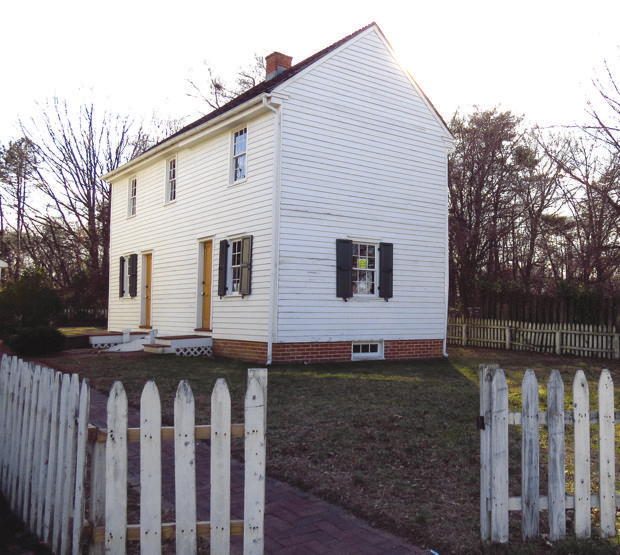
Davie, Isaac, James and Hannah defied the odds. In 1840, the four siblings fled slavery on the shores of eastern Maryland in search of freedom. Their destination: Haddonfield, where help awaited from the Quakers who were an integral part of New Jersey’s Underground Railroad.
“Their parents were dead,” relates Kate Rushin, Davie’s great-great granddaughter, “so the three brothers and their sister desired to remain near one another in their start of a new life for themselves.”
That was easier said than done. Traveling largely on foot, the four siblings—their ages are unknown—crossed three state lines, constantly on the alert for slave hunters and their spies. Finally, they reached southern New Jersey, where participants in the area’s Underground Railroad brought them safely to Haddonfield. There they were able to start new lives as free people under their chosen surname, Arthur.
Their success “says a lot about their character, their love, their commitment to each other and their faith in God,” says Rushin, whose roots are in Lawnside, a Camden County town established in 1840 as a haven for former slaves and other African-Americans.
The story of the four siblings also says a lot about New Jersey’s role in the Underground Railroad, a loose network of secret routes and safe houses operated by abolitionists and other volunteers known as conductors to help slaves escape bondage.
Runaway slaves like the Arthurs usually entered New Jersey by crossing the Delaware River or Delaware Bay at night in a small boat operated by local conductors. The boats used a system of signal lights, yellow on top and blue on the bottom. When the captain saw the same arrangement of lights on shore he knew it was safe to land. Often the runaways had to elude slave catchers patrolling the waters.
Some freedom seekers arrived in New Jersey secreted in canal boats transporting coal from Pennsylvania. These men, women and children were often hidden in cramped, cave-like compartments under the boat’s cabin, the hatches covered with coal for secrecy. There, breathing coal-dust-laden air, they anxiously awaited the next leg of their journey.
Runaways would be taken to one of the four main starting points on New Jersey’s Underground Railroad: Cape May, Greenwich/Springtown, Salem or Port Republic. Traveling north to Camden or Mount Holly, they would be funneled into one of central New Jersey’s seven major escape routes. From there, they would be transferred to conductors on one of northern New Jersey’s escape paths. The state’s various Underground Railroad routes often intersected and usually led to a point on the Hudson River, like Jersey City, where fugitives could cross into New York City and then continue north to freedom in upstate New York or Canada.
Abigail Goodwin of Salem was a conductor on New Jersey’s Underground Railroad and part of the Quaker Society of Friends network sought by the Arthur siblings. Her work on behalf of fugitive slaves is known today thanks to her nephew’s surviving diary as well as her preserved correspondence with William Still, a New Jersey native and famous Underground Railroad conductor from Philadelphia. In her letters to Still, Abigail poured out her worries about the dangers her fugitive guests faced:
“I am afraid it’s so cold, and one of them had a sore foot, they will not get
away—it’s dangerous staying here. There has been a slave-hunter here lately,
I was told yesterday, in search of a woman; he tracked her to our Alms-house.”
As Abigail’s letter suggests, runaway slaves faced constant risk of capture; no hiding place was truly safe. Some, however, offered better concealment than others. Reverend William S. Hall, a Quaker who owned the Cranbury Inn, evidently remodeled a chimney flue at the inn into what was known as a body-hiding box, accessed by a trapdoor. The space, which was concealed behind a wall and held up to four people, can be seen today by visitors to the inn. Such hiding places were cramped, and the occupants were completely dependent on their hosts for the most basic necessities.
“Imagine what it was like to have given up your total physical well-being to a stranger and have to wait for that person to provide you with something to eat and drink and tell you when it was safe to go to the bathroom,” says Gay Ingegneri, who owns and operates the Cranbury Inn with her husband, Tom. “Imagine how cold it must have been in winter and how hot in summer.”
A trapdoor also concealed the hiding space at the Bethel African Methodist Episcopal (A.M.E.) Church in Greenwich Township. The secret five-foot-square-room still exists beneath the present-day altar. According to Reverend Melvin Johnson, the church, constructed in 1838 and still serving a congregation today, often was the first stop for many slaves after crossing the Delaware River. They would then be sent to the next safe house along the route in Springtown.
One of the only known Underground Railroad stations in New Jersey owned and operated by an African-American was located in the black community of Snow Hill (present-day Lawnside). Peter Mott was born in Delaware, and evidence suggests that he was a free man, though he may have been born a slave. Records show that in 1844 Mott purchased property in Snow Hill for $100 and built a two-story home. He and his wife, Eliza, used their home as an Underground Railroad station while Mott worked as a preacher and the first Sunday-school superintendent of the Mt. Pisgah A.M.E. Church.
“Oral tradition says Peter carried the freedom seekers in his wagon to the Friends in Haddonfield and Moorestown,” says Linda Shockley, president of the Lawnside Historical Society. “When the Motts were hiding runaway slaves, the women in the community would help Eliza by cooking extra food.”
In 1992, the Lawnside Historical Society acquired and restored the Mott house, opening it as a museum in 2001. Visitors can watch a film, The Best Kept Secret, about the house and town’s history; view artifacts uncovered during an on-site archeological dig; and examine items donated by William Still’s descendants, including a pocket watch, opera glasses and .22-caliber Derringer pistol. Tour guides, dressed in period costumes for special events, take visitors through the Mott kitchen and parlor, which contain authentic 19th-century furniture, and show them the cellar, a replica of one of the possible slave hiding places.
Some New Jersey homes that served as Underground Railroad stations are private residences today. The four-story, 18-room Hilton-Holden House in the Paulus Hook section of Jersey City probably seemed elaborate when it was built in 1854, especially considering its rooftop observatory. David Le Cain Holden, a banker and amateur astronomer, used the observatory to send and receive signals when it was safe to move the runaway slaves harbored in his basement. The only house on the street at the time, today this notable safe house stands anonymously in a crowded row of neighboring homes.
Many of New Jersey’s safe houses no longer exist, but their stories endure. Dr. Henry D. Holt, a well-known Jersey City physician and abolitionist, used his position as the editor of the Jersey City Advertiser and Bergen Republican to denounce slavery. His home at 134 Washington Street on the Hudson River’s Morris Canal Basin was an Underground Railroad station.
Harriet Tubman, the most famous fugitive from slavery, made 19 Underground Railroad trips, leading more than 300 slaves to freedom. According to oral history, Tubman used the Bethel A.M.E. Church on some of her passages north and worked as a cook in Cape May hotels during the summers of 1849 through 1852 to raise money for her Underground Railroad journeys.
Like the Arthur children, all slaves who traveled New Jersey’s Underground Railroad had dreams of freedom and better lives. The annual Arthur’s Day Event at Mt. Pisgah A.M.E. Church, scheduled this year for March 8 and open to the public, honors this history. For almost 60 years, Davie, Isaac, James and Hannah’s descendants, many still living in the area, have gathered to retell their story.
“The generations that are here now are here because of what they did,” says Rushin. “We have a responsibility to keep the legacy and tradition going and to pass them forward to those coming up behind us.”
Patricia Weigold Fiaschetti is a freelance writer in Kingwood Township.



